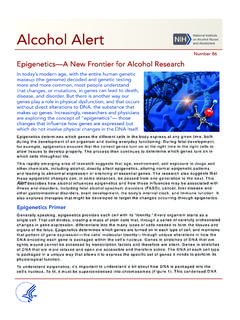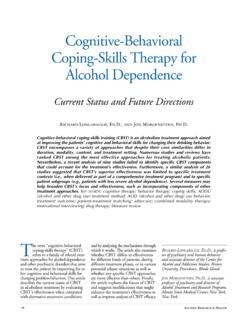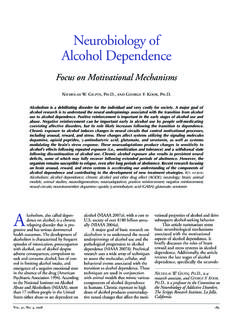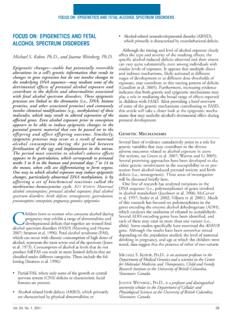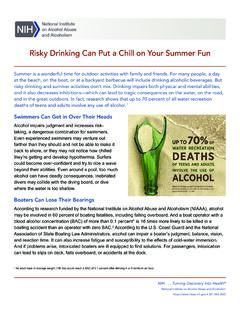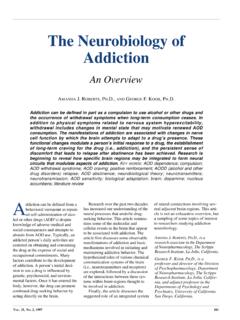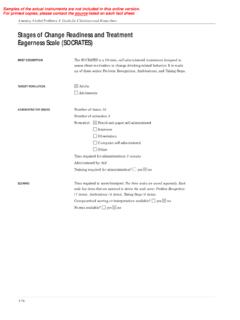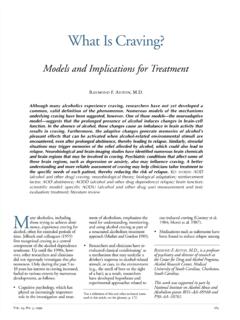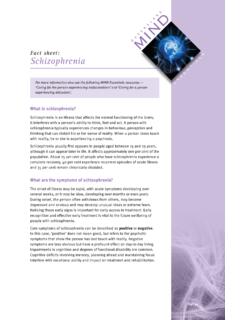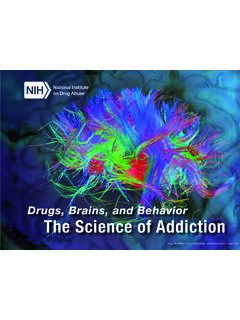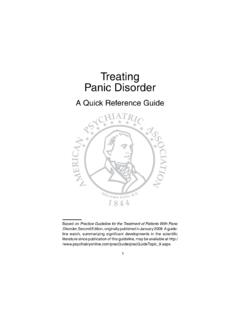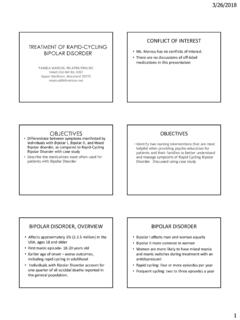Transcription of Alcohol and Neurotransmitter Interactions
1 144 ALCOHOLHEALTH& RESEARCHWORLDS cientists have long sought themechanisms by which alcoholacts on the brain to modify be-havior. An important finding is thedemonstration that Alcohol can affectthe function of specific neurotransmit-ters1(Lovinger et al. 1989). Studies ofneurotransmitters and the receptors towhich they bind have provided dataon both the structure and the mecha-nism of action of these molecules aswell as clues to their role in , the function of individualneurotransmitters and their receptorscannot entirely explain a syndrome ascomplex as systems do notfunction in isolation. Therefore, scien-tists are paying increasing attention tothe integration of communicationsystems in the brain. Although thestudy of neural integration is in itsinfancy, enough has been learned tohelp guide future research.
2 This articlesuggests mechanisms by which alco-hol consumption may affect multipleneurotransmitter systems to among neurons isorganized in interacting levels. Themost basic level of complexity is thearrangement of connections ( ,synapses) between individual andNeurotransmitterInteractionsC. FERNANDOVALENZUELA, , suggests that Alcohol affects brain function by interacting with multipleneurotransmitter systems, thereby disrupting the delicate balance between inhibitoryand excitatory neurotransmitters. Short-term Alcohol exposure tilts this balance in favorof inhibitory influences. After long-term Alcohol exposure, however, the brain attemptsto compensate by tilting the balance back toward equilibrium.
3 These neurologicalchanges occur as the development of tolerance to Alcohol s effects. When alcoholconsumption is abruptly discontinued or reduced, these compensatory changes are nolonger opposed by the presence of Alcohol , thereby leading to the excitation ofneurotransmitter systems and the development of Alcohol withdrawal syndrome. Long-term Alcohol intake also induces changes in many Neurotransmitter systems thatultimately lead to the development of craving and Alcohol -seeking behavior. KEY WORDS: Neurotransmitter receptors; neurotransmission; AODE ( Alcohol and other drug effects); AODuse behavior; AOD tolerance; AOD withdrawal syndrome; AOD craving; biological inhibition;memory; reinforcement; biochemical mechanism; literature review C.
4 FERNANDOVALENZUELA, , , is an instructor in theDepartment of Pharmacology,University of Colorado, HealthSciences Center, Denver, for this work was provided byNational Institute on Alcohol Abuseand Alcoholism grant cells ( , neurons) communicate byreleasing chemical messengers called neuro-transmitters, which bind to receptor proteins onthe surface of other neurons. This process iscalled neurotransmission. For definitions oftechnical terms used in this article, see centralglossary, pp. 177 neuron may connect with up tohundreds or thousands of adjacentneurons (Shepherd 1994). Each neu-ron releases one or a few differenttypes of neurotransmitters. Each re-ceptor type responds preferentially toone type of Neurotransmitter .
5 How-ever, subtypes of the same receptormay respond differently from oneanother depending on the neuron oron the part of the brain in which thereceptor is located. Inhibitory neuro-transmitters transiently decrease theresponsiveness of other neurons tofurther stimuli, whereas excitatoryneurotransmitters produce the oppo-site effect . Some neurotransmittersproduce longer lasting changes, con-tributing to processes such as learningand memory. Chemical messengerscalled neuromodulators modify theeffects of higher levels of orga-nization integrate the various func-tions of adjacent groups of the highest level of complexity areneural pathways, sequences of neu-rons communicating through severalbrain regions (Shepherd 1994).
6 EFFECTS OFSHORT-TERMALCOHOLCONSUMPTIONS hort-term Alcohol consumption de-presses brain function by altering thebalance between inhibitory and exci-tatory neurotransmission (see figure).Specifically, Alcohol can act as a de-pressant by increasing inhibitory neu-rotransmission, by decreasingexcitatory neurotransmission, orthrough a combination of s depressant effect on neu-rons may be associated with some ofthe behavioral manifestations of in-toxication: Alcohol consumption isinitially accompanied by decreasedattention, alterations in memory,mood changes, and acute consumption mayresult in lethargy, confusion, amnesia,loss of sensation, difficulty in breath-ing, and death (Draski and Deitrich1995). Alcohol s excitatory actions( , reduction of social inhibitions)appear to be caused, at least in part,by suppression of inhibitory neuro-transmitter systems (Pohorecky 1977).
7 Alcohol Increases InhibitoryNeurotransmissionThe main inhibitory neurotransmitterin the brain is gamma-aminobutyricacid (GABA). Acting through a recep-tor subtype called GABAA, GABA leads to a state of sedation and de-creased anxiety. Sedative medicationssuch as the benzodiazepines ( ,Valium ) also act at the GABAA receptor. Some reports suggest thatshort-term Alcohol exposure increasesthe inhibitory effect of GABAA recep-tors (Mihic and Harris 1995). Otherresearch, however, shows that alcoholdoes not increase GABAA receptorfunction in some brain regions andunder certain experimental factors probably determinewhether GABAA receptors respond toshort-term Alcohol exposure (Mihicand Harris 1995). Determining themechanisms by which these factorsmodulate the receptor s sensitivity toalcohol is a major focus of are focusing much oftheir attention on other inhibitoryneurotransmitters.
8 Glycine is the majorinhibitory Neurotransmitter in thespinal cord and brain stem. Alcoholhas been shown to increase the func-tion of glycine receptors in laboratoryVOL. 21, NO. 2, 1997145 Running HeadsAlcohol and Neurotransmitter InteractionsInhibitionExcitationInhibiti onExcitationInhibitionExcitationInhibiti onExcitationABCDS chematic representation of Alcohol s effects on the balance of inhibitory andexcitatory neurotransmission in the brain. Under normal conditions, a balanceexists between excitatory and inhibitoryneurotransmission in the Alcohol exposure tilts thebalance toward inhibition by bothenhancing the function of inhibitoryneurotransmitters and neuromodulators( , GABA, glycine, and adenosine)and decreasing the function of excitatoryneurotransmitters ( , glutamate andaspartate).
9 Research suggests that after long-termalcohol exposure, the brain attempts to restore equilibrium by compensatingfor the depressant effects of Alcohol ;thus,the brain decreases inhibitoryneurotransmission and enhancesexcitatory neurotransmission. During Alcohol withdrawal, thesecompensatory changes are no longeropposed by the presence of alcoholand the balance shifts toward a stateof excessive excitation. This state ofhyperexcitation is characterized byseizures, delirium, and (Valenzuela and Harris1997). Alcohol s actions on inhibitoryneurotransmission in this lower area ofthe central nervous system may causesome of Alcohol s behavioral might also increase in-hibitory neurotransmission by increas-ing the activity of inhibitory neuro-modulators, such as of the adenosine systemcauses sedation, whereas inhibition ofthis system causes stimulation.
10 Stimu-lants that inhibit the actions of adeno-sine include caffeine as well astheophylline, a chemical found in studies have shown that caf-feine and theophylline reduce thesedative and motor-incoordinatingeffects of Alcohol (Dunwiddie 1995),although these substances do notalleviate symptoms of intoxication inhumans. Biochemical evidence indi-cates that short-term exposure to alco-hol of nerve cell cultures in thelaboratory increases the levels ofadenosine that can interact with adeno-sine receptors. Thus, an Alcohol -in-duced increase in adenosine levelsmight be responsible for part of alco-hol s sedative systems mayinteract to produce the sedative effectsof Alcohol . An example of such inter-action occurs in Purkinje cells, a typeof neuron found in the cerebellum.

